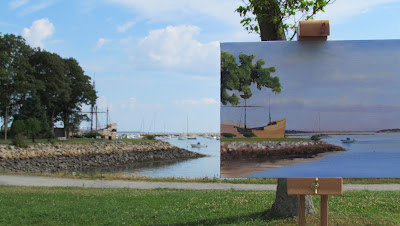Last week we were experiencing pop up showers every day. I usually try to take advantage of painting places that have overhangs or shelters on such days. On the day I started this painting, I used the most convenient sheltered spot of all, my front porch. My street runs north-south and for this painting, I am facing south looking at my porch, shrubs, flag and the street beyond.
 |
| Front Porch Painting Stage One |
I used a 11x14 inch canvas and there was quite a lot of content in the scene that I had framed with my viewfinder. If think if I was out for a single painting session, I would have wanted to simplify the scene so that it would be more managable by eliminating things. The engineer in me leans toward making everything more complex than it needs to be and I decided to go for it all in a multi-day effort.
I started with a line drawing with paint because there were so many structural elements. I then worked on the distant sky, trees and houses along the street. Since it was overcast at the start, the values of the various planes in Stage One were mid-range. The furthest parts of the scene were developed, the porch structure framing the distance.
At quitting time I lightly marked the placement of the three legs of my easel on my porch floor so that I could repeat my set up more easily on subsequent days. On my next painting day, it was late on a sunny afternoon. My neighbors' houses on the same side of the street as me were throwing nice long shadows across the street. Also, the left side of the street was brightly lit by the late afternoon sun. I was glad to have a good structural drawing from the cloudy day. Now I could concentrate more on the sunny versus shady planes.
I initially found myself not wanting to include parked cars and mundane objects like trash barrels and recycling bins thinking these made the scene look ugly. After I put the cars in, I was glad I did, since that is the way it typically looks in summer. They also added some interest; anything painted seems to get elevated in status.
 |
| Front Porch in July |
One of the corrections I made during session three of this painting was to slightly reposition and size the porch posts. For some reason all of the posts were not level. I had placed the top of the post exactly in the proper place, but as I extended the post down to the porch floor, I sloped them about five degrees off. I only discovered this because I measured with my ruler. I had evidently become blind to my misalignment. I have done this before with verticals which is why I do this doublecheck
On day three of the painting I started filling in the foreground. The white Adirondack chairs were completely in shade, so I had to force myself to make these nice white chairs dark enough. The porch wood is also white and I intentionally made them darker than they should be so that my finishing strokes would be relative to the rest of a completed painting.
I plan on coming back to this after the painting has a chance to dry and will post again with my last session's work.


















